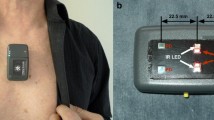Abstract
The pulse oximeter can serve as a sensitive photoelectric plethysmograph in the operating room. It was noted in several cases that the plethysmographic waveform showed a high degree of variability during diastole. Three patients are described with discrete diastolic peaks on the plethysmograph. Further investigation revealed that these diastolic peaks appear to correlate with peripheral venous pulsation, which seems to have a central venous origin. Evidence is presented that the plethysmographic detection of the venous pulse may be useful in estimating the changing volume status of the patient.
Similar content being viewed by others
References
Eichhorn JH, Cooper JB, Cullen DJ, Maier WR, Philip JH, Seeman RG. Standards for patient monitoring during anesthesia at Harvard Medical School. JAMA 1986; 256: 1017–1020
Coté CJ, Rolf N, Liu LM, et al. A single-blind study of combined pulse oximetry and capnography in children. Anesthesiology 1991; 74: 980–987
Kim JM, Arakawa K, VonLintel T. Use of the pulsewave monitor as a measurement of diagnostic sympathetic block and of surgical sympathectomy. Anesth Analg 1975; 54: 289–296
Dorias JC, Nijboer JA. Photo-electric plethysmography as a monitoring device in anaesthesia. Br J Anaesth 1985; 57: 524–530
Partridge BL. Use of pulse oximetry as a noninvasive indicator of intravascular volume status. J Clin Monit 1987; 3: 263–268
Pologe JA. Pulse oximetry: technical aspects of machine design. Int Anesthesiol Clin 1987; 25: 137–153
Perel A, Pizov R, Cotev S. Systolic blood pressure variation is a sensitive indicator of hypovolemia in ventilated dogs subjected to graded hemorrhage. Anesthesiology 1987; 67: 498–502
Lawson D, Norley I, Korbon G, Loeb R, Ellis J. Blood flow limits and pulse oximeter signal detection. Anesthesiology 1987; 67: 599–603
Palve H, Vuori A. Minimum pulse pressure and peripheral temperature needed for pulse oximetry during cardiac surgery with cardiopulmonary bypass. J Cardiothorac Vase Anesth 1991; 5: 327–330
Guyton AC. Vascular distensibility and functions of the arterial and venous systems. In: Guyton AC, ed, Textbook of medical physiology, 8th ed. Philadelphia: Saunders, 1991: 159–160
Sami MS, Kleinman SK, Lonchyna VA. Central venous pulsations associated with a falsely low oxygen saturation measured by pulse oximetry. J Clin Monit 1991; 7: 309–312
Author information
Authors and Affiliations
Rights and permissions
About this article
Cite this article
Shelley, K.H., Dickstein, M. & Shulman, S.M. The detection of peripheral venous pulsation using the pulse oximeter as a plethysmograph. J Clin Monitor Comput 9, 283–287 (1993). https://doi.org/10.1007/BF02886699
Received:
Revised:
Accepted:
Issue Date:
DOI: https://doi.org/10.1007/BF02886699




